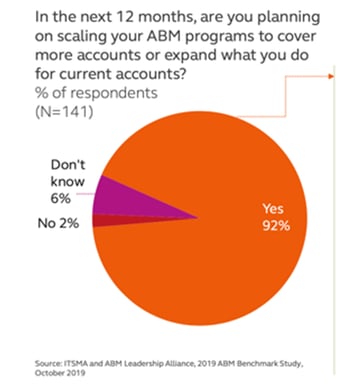Even if you've never heard of or used ABM marketing strategies before, the chances are the basic concept has crossed your mind at least once.
Think about how many times you've said “Blah-blah would be a perfect company to do business with” or “Do we know anyone at XYZ who could get us an introduction to the CEO?”.
A little bit of background information first... Recently, a new marketing technique has emerged: instead of doing all the usual stuff with focus groups, direct mail, surveys and demographics, companies are now trying to get to know individual customers by name.
While there is much discussion about AI in marketing, the focus tends to revolve around marketing automation, a valuable time and effort-saving tool for marketers. Nevertheless, we can further capitalize on AI's potential by empowering sales and marketing teams to bolster their account-based marketing efforts.
ABM allows you to focus your marketing on target accounts. This is useful if you want to target companies, organisations (for example universities) or people with a specific function (for example finance directors).
Check out the following blogs to learn more about Account Based Marketing:
- Account Based Marketing - All you need to know in 2023
- How to Grow Your B2B Audience with Account-Based Marketing
- The Best Account-Based Marketing Tips for B2B Tech Companies
- How to Craft Winning ABM Email Campaigns for Your Business
What is Account Based Marketing?
Such thoughts and statements are at the heart of ABM (Account Based Marketing), the practice of creating highly customised campaigns for specifically targeted accounts. If you've acted on statements similar to those above, you might already be developing ABM strategies without even realising it.
An alternative perspective on ABM and account-based marketing programs is to view them as an inversion of the traditional marketing and sales team funnel, as Drift explains. While standard marketing strategies often adopt a scattergun approach across markets and sectors, ABM begins with targeted accounts that offer the best revenue-generating opportunities and align with the key accounts of your marketing and sales team. For clarity, here are some account-based marketing examples that illustrate this approach.
Rather than whittling down many prospects to a list of the warmest leads, the aim here is to land the exact clients you're looking for or to expand the spend of those you already work with by developing highly personalised campaigns to generate leads.
In truth, while the focus may be different, ABM isn't that far removed from standard inbound marketing and can work hand in hand with many of the techniques you already use.
A marketing team now needs to be at the forefront of this new wave of marketing technology, as a successful ABM program is changing how marketers operate, and we're proud to help lead that change.
This is mainly because it is a comprehensive B2B marketing strategy that targets a specific account and the primary decision maker, rather than an entire market.
Instead of casting a wide net, you can focus your account specific experience on the main key accounts with high potential for long-term value to your business.
By leveraging targeted marketing channels such as PR driven articles, a dedicated landing page, personalized video, and Google alerts, specific accounts can be engaged to initiate long sales cycles, driving traffic and lead generation. This strategy is in line with the account-based marketing model and aims to maximize revenue potential from your ideal customer.
ABM is not new, it has been around for almost 15 years now, but only recently has it started to catch fire in B2B marketing circles.
As the author of one Forbes article put it, "ABM is hot again." Why? Because what worked before failed us in recent years.
Now, it is hot topic again in the B2B marketing world and it is one of the most popular topics at marketing conferences and is amazingly effective when you want sales teams work to target best fit accounts and focus on a select group of accounts and create individual experiences with those accounts.
What are the benefits of account-based marketing tactics?
There are many reasons to deploy ABM techniques for your business, but one of the most important is also the simplest – it works. The ITSMA suggests that most ABM programmes generate a greater return on investment than other types of marketing, with many companies intending to increase investment in ABM budget and resource by 20% this year.

Image source
Beyond these compelling statistics, also consider the following when deciding to adopt an ABM approach.
Account based marketing for small business can be used to…
- Help to bridge gaps between marketing and sales teams by providing them with a common goal
- Demonstrate clear potential ROI
- Reduce wasted marketing resource
- Drive a better, more personal customer experience
- Enhance relationships with multiple stakeholders, key clients and land new ones
-----------------------------------------------
4 Popular ABM Marketing Strategies
While there are many ways to approach an effective account-based marketing strategy, these four elements are essential for identifying and engaging with your target audience and aligning your digital marketing efforts to land those all-important key high-value accounts based on these four marketing approaches for any sales cycle.
1. Define your targets
Before you dive into account-based marketing activities, it is understood that pinpointing target key accounts is necessary. Which companies (and their customer success teams) currently deliver the most revenue to your business and what do they have in common? Which organisations are a perfect match for your product or service?
To achieve account-based marketing success and adopt a targeted marketing approach, it's crucial to identify the types of companies where you can add value and that can significantly benefit your business. Defining the company size and specific pain points or challenges that align with your offering and available resources will be essential in pinpointing the organizations you should target, ultimately yielding the best returns.
2. Dig into data
Data is the cornerstone of most modern marketing initiatives, and ABM is no different.
However, unlike traditional marketing activity, ABM requires a slightly different and more involved approach across the whole sale cycle.
Where you would normally seek ripe leads across a demographic or industry, ABM is about accessing specific company information to better inform and focus your campaigns.
In addition to investing in such insight, making use of your existing internal data can also be fruitful. By slicing existing information in a more targeted manner than you would for broader campaigns, you can shine a light on new approaches and hidden ideas unique to specific companies.
But don't stop there…
You can also make use of more personal approaches to data using ‘social intelligence' to lock down key decision makers and role-specific information.
Make use of social media to better understand your targets and use tools on popular platforms like LinkedIn to find the right people to engage with.
Finally, ask colleagues (even those outside the sales team) to run through their contacts and see if they're connected to any potentially useful stakeholders at your target companies who could aid introductions or provide more detailed information.
3. Develop unique content, offers and campaigns
The best advertising can make a simple product feel like the thing that's been missing from your life. That's what your ABM campaigns should do for your target leads.
Create personalised landing pages, ads, email campaigns and other forms of content that directly address the challenges faced by the company and show how perfectly your business can serve their needs.
Create thought leadership blogs that reference your targets and make sure to tag or mention them when you share those assets on social media to increase the chances of that magical ‘aha' moment.
You can even make this process a step further and create entire white papers, personalized content or eBooks based on your target company, making sure to explain how you could solve their problems or to influence major purchase decisions for a target account list.
Using the data, you've gathered already should help to inform such activities as well as choose the right individuals to put this uniquely targeted brand of content marketing in front of.
4. Choose the right channels and measure success
Like any B2B marketing campaign, the interaction between different channels is an important part of ABM, as is choosing the ideal channels to support your initiatives.
A targeted ad may work well for one person, while a well-positioned blog or social media post might be better for another. This level of personalisation is essential to open doors within your target business and sales process.
Drawing on the data and research you've already completed, tailored email campaigns with content specific to the individual's role can help to enhance engagement and start conversations that traditional catch-all marketing messaging can't.
And finally, while less of a marketing tactic and more essential marketing practice, measurement of your ABM campaign is key. Monitor the level of engagement across channels and learn from the results, from simple metrics like whether revenue increased to more granular data such as whether you're interacting with more individuals from your target companies and if they engaged with the personalised content you created.
Use this information to inform your next campaign.
Conclusion: personalised campaigns based on understanding
These effective account-based marketing program tactics will provide a solid foundation for your personalised campaigns and help you to approach key targets in a more direct and engaging manner. However, as we've discussed, personalisation is the key here, and what works for one account may not be as successful for another.
Therefore, the research and data gathering stages are so crucial.
Knowing your targets inside out, from their business needs to their posts on social media is key to knowing your audience and understanding how to engage them using content and language that resonates.
Don't forget that account-based marketing has been around for as long as B2B itself. From the days of sales reps selling to mainframe computer departments, where marketing teams understand that high value target accounts always come form a specific target account, which is more efficient than a sales rep just casting a wide net.
But a recent wave of innovation in marketing technology has brought ABM back into fashion. In particular, it's made it possible to execute ABM with the same rigor and precision that we've come to expect from digital advertising that may include a sales funnel for social media ads, account planning, web personalization, and/or lead demand generation.
Account-based marketing is the popular new marketing strategy that involves treating individual customers like markets unto themselves and has been a recurring theme in marketing of late: the idea that you should treat customers as individuals, not as faceless members of a mass market.
As sales leaders and marketing analytics firm Everstring CEO J.J. Kardwell explained in a recent article on account-based marketing, "Marketers were trapped in a world where their audience was defined by broad demographics, rather than by data on specific companies' actions."
The problem with this kind of one-size-fits-all approach is that it doesn't work very well, especially when trying to contact decision-makers. This is because, as you well know, in the digital age, everyone is drowning in information and can easily tune out even the most targeted advertising if it's irrelevant to them. Personalized messaging is the key to reaching them is to understand what they care about and what they don't care about, and then focus your efforts on the former.
So, what does all this mean? Account based marketing solves a lot of issues. However, it takes work but, when you make that breakthrough connection with these marketing tactics, the results will be well worth your marketing efforts.
Over to you
Landing the perfect clients requires a rock-solid strategy and pitch-perfect implementation, and Incisive Edge has been helping businesses to identify and engage with their target account-based marketing tactics for high value accounts clients since 2009.
If you're looking to make use of ABM marketing tactics as part of your marketing strategy, why not get in touch or book a free strategic consultation today.








